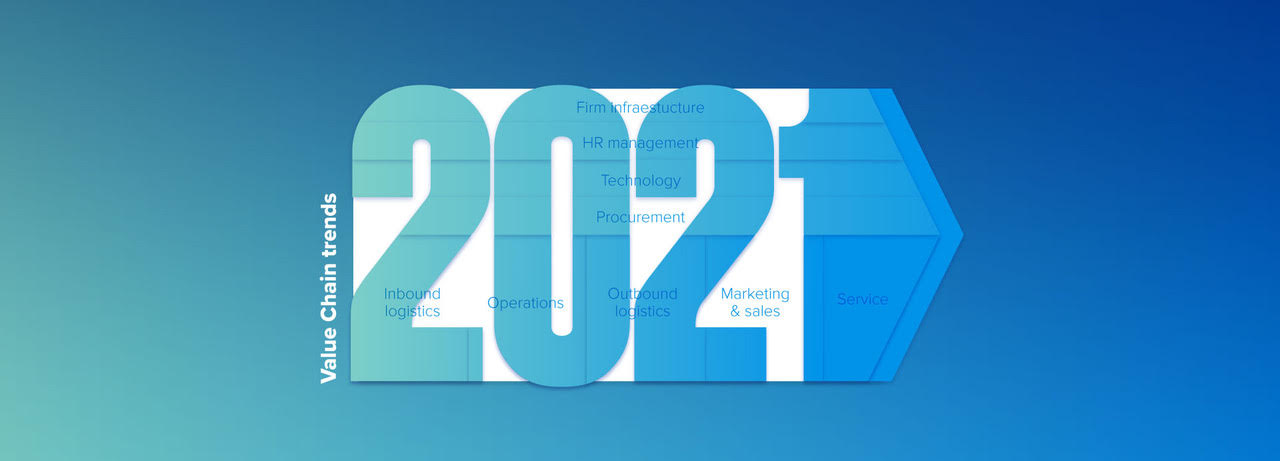This is the time of the year when everybody becomes a futurist. With a quick scan of the web you can find plenty of pundits trying their hands at guessing the future – whether it is “5 Supply Chain Trends We Should Watch in 2021” or “13 Post-Pandemic Supply Chain Trends” there is no shortage of opinions and even a few facts! I’ve read all of them so you don’t have to, so let me share with you my five top value chain trends for 2021.

For me the major lesson of the last year or so it is that companies with poor visibility of risks and disruptions in their supply networks got into difficulties quickly. Some brands, distributers and suppliers won’t return. Businesses that relied on a single channel (typically B2B) to reach the end consumer seem to have been particularly badly affected as consumers pivoted quickly to the most reliable retailers, brands and channels (typically via ecommerce) when shelves started to empty.
I suspect that many of us are still focussed on the near term. In a recent McKinsey article on supply chain recovery they urged companies to act now to create transparency, improve inventory estimation, secure logistics capacity and “respond to (or, where possible, contain) shortage-buying behavior of customers.” The article ends with a plea to prepare for the next and inevitable shock.
Yes, take action to mitigate immediate vulnerabilities, and manage cashflows and working capital, but remember it is important to take time to step back and look forward. With the arrival of multiple vaccines it is possible to imagine that we are seeing the beginning of the end of the pandemic. Personally, I think we will live with significant restrictions on retail until the end of 2021, and consumer and shopper behaviour is likely permanently changed in multiple categories. So which of the many possible trends should you pay attention to?
Five Trends
From reading the myriad of predictions I have identified five value chain trends that I believe offer the greatest insight into how Consumer Goods companies should think ahead and “build back better”.
1. At last, omnichannel will not be optional
Omnichannel is not new: it has been discussed since 2010, and there is still no single definition (have a look at this 2020 publication). Where there is consensus it is that having multiple channels is one thing, but having high service levels and proficiency across all channels in the eyes of consumers and customers is another. Achieving this requires a mastery of data (single view of everything), sleek experiences and processes, and technology to match. From a technology perspective, it is omnichannel that will drive expansion of hybrid-Clouds in Consumer Goods more than possibly any other trigger.
My prediction is that in 2021 we will see large companies prioritising investment in their supply networks and technology infrastructure to develop enhanced omnichannel capabilities that are more responsive to customer (B2B and B2C) demands and preferences. Examples are making product returns much easier, and seamlessly handling wholesale orders and small ecommerce purchases at the same time.
2. Building greater resilience and more agility
In December 2020 a survey by the Association for Supply Chain Management (ASCM) identified risk management and resilience as the number one supply chain trend of 2021. There are many reasons for that choice, but the potential for future shocks to supply and demand remains high. As INSEAD say “in the post-COVID-19 world, contingency planning should be built into every link of the value chain.”
ASCM make an interesting point in the report: it is important to be faster and better than the competition at responding to adverse events. For me, then, this trend is as much about agility as resilience. By agility I mean the organisational ability to renew and re-organise, and a workforce ready to adapt and innovate.
Building agility in 2021 will likely include further network re-configuration, supplier diversification, selective near-shoring and localisation of supply chains, investing in micro-fulfilment centres closer to point of consumption, and the rise of “elastic” logistics and warehousing.
3. The importance of creating on-demand and “everything as a service” networks
Consumer Goods companies have developed tightly-interconnected, global supply networks to facilitate more optimised fulfilment. Today, these vast, extended networks link stores to warehouses, manufacturers and suppliers, and a multitude of third-party logistics providers (3PLs). What I predict will change in 2021 is the role of the 3PLs and the associated business model.
Let’s face it, it is often the 3PLs that are the cornerstone of ecommerce success (particularly in the eyes of the customer), and the pandemic-accelerated shift towards ecommerce distribution will bring their expertise to the fore. During the pandemic 3PLs have been expanding their freight and haulage capacity, upgrading their software systems for logistics and inventory management, and making their warehouses more intelligent and connected.
I think further outsourcing of operational activities from retailers and manufacturers, facilitated by collaborative, digital technologies such as blockchain, will make on-demand, Supply Chain as a Service (SCaaS) models highly attractive in 2021.
4. Making control towers less dumb and less like control towers
Is it just me, or have control towers not lived up to the hype yet? The vision was for data-driven decision-making (human or machine), but many are just dashboards for a sub-set of the value chain. However, there are encouraging signs that they are about to get a lot smarter.
Manufacturers and retailers have continuously invested in extending the scope of the control towers across their business ecosystem. This has been aided by wholesalers and 3PLs prioritising new technology. Internet of Things (IoT) devices have proliferated, and smart contracts are becoming more common in trucking and shipping. Digital twins of the physical supply chain are starting to become more commonplace.
Hence, in 2021 I anticipate that automation, specifically robotic process automation (RPA) and prescriptive machine learning models and analytics will take off. Smart control towers that span planning and execution activities in near real-time will suggest mitigations and resolutions, not just descriptions or predictions of problems.
5. Sustainability is a build back better fundamental
You hear the phrase “build back better” a lot, but few know that its contemporary usage stems from the United Nations’ Sendai Framework for Disaster Risk Reduction. More than a slogan, it is an holistic framework that treats a disaster (such as the pandemic) as a broader opportunity for a more resilient recovery, and net gain in sustainable development is a key component of that recovery.
The current pandemic (and the next one) are the “disasters” top of mind, but climate variability and change, unsustainable use of natural resources, and declining ecosystems are setting Consumer Goods companies up for a much bigger set of challenges across their value chains. Influential brands are following the science and have already incorporated sustainability into their vision and purpose. The behaviour and preferences of a new generation of consumers is encouraging companies to be more transparent about supply chain externalities. Digitisation of value chains is making concepts such as the circular economy more actionable.
Hence, as CapGemini wrote recently “this isn’t going away” and 2021 will see sustainability as an essential pillar of recovery across the industry.
Where Are the Trends Taking the Industry?
I see 2021 as being a balancing act for the larger Consumer Goods companies. Short term action to keep their supply network viable (including loans and cash injections to suppliers), and building on the lessons of 2020 and the re-emergence of supply chains as a strategic focus.
There have been examples of global supply chains suffering some level of difficulty during the pandemic (and Brexit). I believe that these are transient and our global supply networks are here to stay, and I don’t think these trends are taking us to some radical new vision for the Consumer Goods value chain. Rather they validate and substantiate a vision of the importance of extended, customer-centric supply networks based on effective and efficient co-ordination of a broad range of actors (consumers, customers, suppliers, 3PLs etc).
The groundwork was laid out in seminal articles such as” From Value Chain to Value Constellation: Designing Interactive Strategy” in the Harvard Business Review from1993 or “Fast, Global, and Entrepreneurial: Supply Chain Management, Hong Kong Style” also in the Harvard Business Review in 1998. We now have the tools and an immediate incentive to make the vision a reality.
What is new for 2021 is that company Boards are proactively prioritising investments in digitising supply chains and technology, particularly to support extensive and flexible collaboration and innovation. This means more pressure to deliver fast results between CSO, CPO and CIO.
Call to Action
The five trends I’ve highlighted here offer the prospect of building back better with omnichannel, transparent and sustainable value chains, but I’d like to share one last thought. Simply following the trends isn’t enough: I think “be prepared” is a good motto for us in 2021, as some Consumer Goods companies were in 2020 (but many were not). What has saved the day in many instances are the amazing people we have in our industry, and their creativity and dedication. But no one should want to be in reactive mode again when the next major disruption comes along, and there will be a next time. The formula I have in mind is: New Normal = waves of disruptions x technology x new era of globalisation
Being prepared requires activity to build systematic organisational capacity and capability to handle disruptions anywhere in the value chain, and to manage recovery efficiently. Hence, I think it is time to take a hard look at the skills and organisational models that we need to prepare for this New Normal. Perhaps 2021 should be the year that Consumer Goods companies initiate a once in a generation set of organisational changes to build preparedness, starting with the supply chain.
Inevitably any changes will need to go beyond preparedness. Even before the pandemic there were questions about the future of work in Consumer Goods (e.g. the impact of AI, universal basic income, fresh attitudes to diversity and inclusion), and the pandemic has made it abundantly clear who the key workers really are. The pandemic has also shown how fragile certain organisations in the Consumer Goods value chain are, and how out of alignment with the skill and knowledge needs for the New Normal some employees are. At the very least it seems likely that working from home where possible will remain, and Governments will continue to take broader direct action to re-skill people and to safeguard incomes and employment (at least for the next few years).
Going back to as we were in 2019 doesn’t seem to be a sensible choice or even possible.
To learn more about how the COVID-19 pandemic is impacting CGF members and the consumer goods industry at large, take a look at the Special Edition: Industry Actions to Tackle Covid-19.
This blog was written and contributed by:
Trevor Davis
Industry Expert and Futurist
Trevor Davis and Associates Ltd

